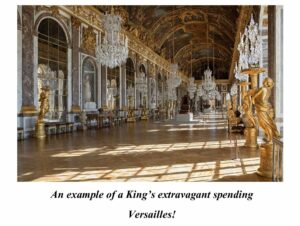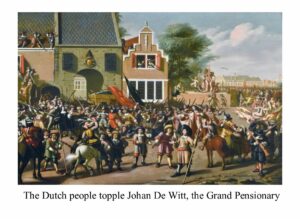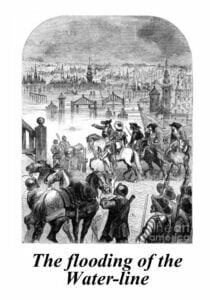This all goes back to Dutch history, and 1672, the year that in Holland they refer to as The Rampjaar (The Year of Disaster).
It was the year when the Dutch found themselves at war with all their surrounding countries even, with the one across the North Sea, England!
They were fighting the French, in what was naturally called the Franco-Dutch War, at the same time it was the start of the Third Anglo-Dutch War. That year France, also supported Münster and Cologne to invade the Dutch Republic, and they nearly overran it.
Why, you may well ask, did everyone want to invade Holland, what had they done wrong?
It was all because they were a Republic.
The problem was that the Netherlands, even though it was a small country, was wealthier than the others. It appeared that this was because they were a republic not a Monarchy!
This caused a problem with the Monarchies, as it upset the normal state of things, they therefore wanted to correct the situation by invading them.
The problem with republics
It was the way they were governed.
Holland was governed by the States General, an assembly of delegates representing all the Provinces of the Netherlands. Now, each separate province of the Dutch Republic was its own sovereign state. However, they then sent representatives to the States General. The States General was the governing body of the Provinces of the Netherlands., which elected a Stadholder, who was, in effect, an elected King.
The problem for the other nations was that this was of enormous financial benefit to the Netherlands.
 You see, Kings were expensive, they spent lots and lots of money. For example, Louis 14th built Versailles, it wasn’t cheap! This meant that to do this they borrowed, and they borrowed lots!
You see, Kings were expensive, they spent lots and lots of money. For example, Louis 14th built Versailles, it wasn’t cheap! This meant that to do this they borrowed, and they borrowed lots!
Now we come to the problem, in those days when a king died, his debts died with him.
Naturally, this influenced the interest rate the Kings had to pay when they borrowed.
On the other hand, with a republic its debts didn’t die, as there was no King to die!
Therefore, the United Provinces of The Netherlands borrowed at a much lower interest rate. This allowed the Dutch merchants to create and then sell their products abroad at a lower price. The result was that one of the smallest countries in Europe was, in fact, the most economically successful one in the late 1600s. Basically, you could call them the Singapore of the 17th century.
Then in 1672 it all fell apart!
The monachies decided to do something about it. Therefore, the French and two of the German Bishoprics, German Catholic states, massed on the Dutch border. While at the same time the English tried to set up a naval blockade of the Dutch ports in support of the French.
The English blockade came about as result of the Secret Treaty of Dover between the British King Charles II and Louis XIV of France. It was secret, King Charles II of England had agreed that at some future date England would become a Catholic nation again. At the time such a move would not have been popular. In fact, 17 years later, this led to an interesting result, but more of this later.
There was to be a two-pronged attack on the Netherlands. The French were to invade from the south, while the Anglo-French fleet would land an army on the Dutch coast, bypassing their defences.
 However, the Dutch snatched a naval victory at the Battle of Solebay on 28 May 1672 stopping the planned Anglo-French invasion of the northern Netherlands.
However, the Dutch snatched a naval victory at the Battle of Solebay on 28 May 1672 stopping the planned Anglo-French invasion of the northern Netherlands.
The Revolution
Then there was a revolution in the Netherlands. Johan De Witt, the Grand Pensionary, who was running the country at the time, was toppled, and replaced with a new Stadholder, William of Orange.
When he took over, the situation was bleak. Prince William therefore decided to flood the water line and to concentrate his forces behind it.
The Water Line
 Back in 1629, Prince William’s grandfather came up with a plan to protect the Netherlands from invasion.
Back in 1629, Prince William’s grandfather came up with a plan to protect the Netherlands from invasion.
He linked a series of lakes and canals to create a line from just under Amsterdam to Dordrecht in the south. Then he built a series of sluices, dikes, forts, and fortified towns with guns pointing across the areas to be flooded. This was the clever bit as he made certain that the area to be flooded was deep enough that you couldn’t march across it. While at the same time it was too shallow for boats to cross, other than the flat-bottomed gun boats he had designed. Into the area to be flooded, below the level of the water, he put things like ditches, barbed wire and even mines!
As you can see, he didn’t intend the country to be invaded.
Forty years later his grandson, William, used it and flooded the water line. It worked. It really did stop Louis XIVth armies in their tracks.
He used this time to strengthen the weak points in his defenses and train his army. With the result that by the autumn he had 57,000 trained men safely behind the water line.
Of course, those provinces outside the waterline were defenseless and quickly fell to the French. It took William a further year before he could sign an alliance with the Holy Roman Empire, Brandenburg-Prussia and Spain against France. This was because these states began fearing Frances’s power, so they joined Prince William and within a year the Netherlands was free again.
Did this lead to the events of 1689?
Over the years Prince William married Mary, the daughter of King James of England.
I said earlier that King Charles had hidden his treaty as the British were violently protestant, this led to the events of 1689. At the time the English King was a Catholic and the People were Protestant, they didn’t want another civil war, so the Parliament turned to Prince William.
With the result that in 1688 Prince William landed an Army on English soil, at Torbay, in the southwest. On landing he proclaimed, “the liberties of England and the Protestant religion I will maintain”. He then marched his army to London. He was cheered all the way. Even the army sent to stop him changed sides and joined him! As I said, England was a protestant country and the people felt that they had a catholic king, something they didn’t want.
Fortunately, neither did the Protestant English Parliament, but more importantly they didn’t want another civil war.
The result was that on 13th February 1689 William and Mary became King and Queen of England.
The agreement he made with Parliament was the basis for the current relationship between the Parliament and the Monarch, which at the time was similar to the system in the Netherlands but England did not become a Republic.
Imagine that, 17 years after England had attempted to invade, and then lost several sea battles to the Netherlands, the Dutch Stadholder became King of England!
Therefore, the problem with Monarchies produced a different kind of result, one that in the end saved the future of the English crown!
Isn’t history fun!
10 questions to discuss:
- What significant event occurred in Dutch history in the year 1672, and why is it referred to as the Rampjaar (The Year of Disaster)?
- Describe the political structure of the Netherlands during the late 1600s and how it differed from monarchies.
- How did the governance structure of the Netherlands contribute to its economic success in the late 17th century?
- What were the main reasons behind the multiple invasions of the Netherlands in 1672 by France, England, Münster, and Cologne?
- Explain the significance of the Secret Treaty of Dover between King Charles II of England and Louis XIV of France in relation to the events of 1672.
- Detail the planned two-pronged attack on the Netherlands by France and England in 1672, and how the Dutch countered it.
- Who was Johan De Witt, and what led to his removal from power during the revolution in the Netherlands in 1672?
- Describe the Water Line and its role in defending the Netherlands against invasion in 1672.
- How did Prince William of Orange utilize the Water Line to defend against the French invasion in 1672?
- Explain the connection between the events of 1672 in the Netherlands and the events of 1689 in England, specifically regarding the ascension of William and Mary to the English throne.
For more information on this click on:
https://www.britannica.com/event/Treaty-of-Dover.
https://www.aronson.com/the-disaster-year/
https://www.wikiwand.com/en/Dutch_Water_Line
©Tony Dalton

